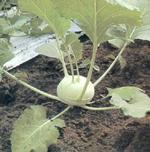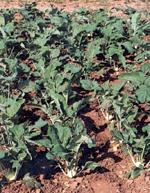| Fruits |
Vegetables
|
Kohlrabi, Brassica oleracea var. gongylodes / Cruciferae (Brassicaceae)
|
Note: Composition for 100 g. of fresh product Values in ( min. - max. ) format. | |
| Energy: 23.94-23.94 kcal Fats: 0.10-0.10 g Fibres: 1.44-1.44 g Minerals Calcium: 68.00-68.00 mgZinc: 0.260-0.260 mg Chlorine: 57.00-57.00 mg Phosporus: 49.70-49.70 mg Iron: 0.900-0.900 mg Magnesium: 43.00-43.00 mg Manganese: 0.130-0.130 mg Potasium: 380.00-380.00 mg Selenium: 0.700-0.700 µg Sodium: 32.00-32.00 mg Iodine: 0.59-0.59 µg | Proteins: 1.94-1.94 kcal Carbohidrates: 3.70-3.70 g Liposoluble Vitamins A Retinol: 33.33-33.33 µgA Carotenoids: 200.00-200.00 µg Liposoluble Vitamins B1 or Thiamine: 0.048-0.048 mgB2 or Riboflavine: 0.046-0.046 mg B5 or Pantothenic Acid: 0.100-0.100 mg B6 or Piridoxine: 0.071-0.071 mg B9 or Folic Acid: 63.30-63.30 mg C or Ascorbic Acid: 63.30-63.30 mg |

The kohlrabi belongs to the cabbage family, although, in general, it is not known. It is consumed mainly in the countries of the north of Europe, like Germany, Switzerland and Austria, cooked as well as raw in salads. It contains vitamins and minerals, and it is low in calories.
Nutrition and eating
The kohlrabi contributes to mineral and vitamins for the organism. In addition, it is low in calories and fats and rich in fiber. It is appropriate for people with high blood pressure and heart or kidney diseases. It also helps to prevent some types of cancer.
The fruit
 The kohlrabi belongs to the cabbage family, although, in general, it is not known. It is consumed mainly in the countries of the north of Europe, like Germany, Switzerland and Austria, cooked as well as raw in salads. It contains vitamins and minerals, and it is low in calories.
The kohlrabi belongs to the cabbage family, although, in general, it is not known. It is consumed mainly in the countries of the north of Europe, like Germany, Switzerland and Austria, cooked as well as raw in salads. It contains vitamins and minerals, and it is low in calories.Although the young leaves can be consumed, it is mainly produced because the stem’s base grows like a tubercle, turning into white, green or red. It is harvested when it has approximately the size of a tennis ball. Its flavor is similar to the turnip.
It is an uncommon culture, although kohlrabi it is highly appreciated in the Nordic countries, representing an alternative to the turnip culture in dry areas, since it is less demanding for water. It is cultivated mainly in Germany, Austria and Switzerland.
It is cooked for soups and salads, to which it provides a spicy flavor. Normally it is peeled, cut in dices and boiled, although it can also be grated for salads. The leaves are cooked and eaten as a cabbage.
It contributes with vitamin C, A, B1, B3 and B6, and it is rich in phosphorus, calcium and magnesium. It is recommended for diets, since it is low in calories and it hardly contains fats. It has a low sodium level, thus people with high blood pressure can also consume it.
The plant

The kohlrabi or turnip-rooted cabbage is similar to the turnip. The inferior part of its stem enlarges forming a kind of greenish or red white tubercle. This stem’s growth develops some leaves that remind us to the turnip’s.
The kohlrabi belongs to the family of the Brassicas and its scientific name is Brassica oleracea var. gongylodes.
The part that develops into a tubercle, where the leaves grow, is the one used for trading. The petioles are long and thin, and the leaves recall the turnip’s. The stem’s base color ranges from greenish white to reddish.
It is a rustic plant that bears harsh climates. Its growth is scarce, reaching at the most 30cm high. It has a very fast maturation, since it is developed in a pair of months from the seeding to the harvesting. It must be harvested when the tubercles are scarcely developed; afterwards, they will harden, loosing their quality.
The kohlrabi belongs to the family of the Brassicas and its scientific name is Brassica oleracea var. gongylodes.
The part that develops into a tubercle, where the leaves grow, is the one used for trading. The petioles are long and thin, and the leaves recall the turnip’s. The stem’s base color ranges from greenish white to reddish.
It is a rustic plant that bears harsh climates. Its growth is scarce, reaching at the most 30cm high. It has a very fast maturation, since it is developed in a pair of months from the seeding to the harvesting. It must be harvested when the tubercles are scarcely developed; afterwards, they will harden, loosing their quality.
| Interempresas Media, S.L. / 2026 | [ Legal notice | Política de Protección de Datos | Política de cookies | Publicidad] |
